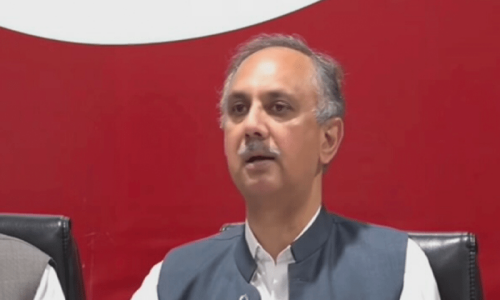SUKKUR: With a remarkable rise recorded in the Indus water level at Guddu and Sukkur barrages on Sunday night, the district administrations of Sukkur, Ghotki and Khairpur on Monday launched a massive operation to shift the kutcha area population to relief camps. Floodwaters overtopping some irrigation channels in Pannu Aqil inundated agricultural lands and more than 30 villages of the kutcha area, according to irrigation authorities.
Leader of the Opposition in the National Assembly Syed Khursheed Ahmed Shah visited the affected and vulnerable areas of Sukkur district on Monday and inspected the protective dykes.
Earlier, the Sukkur Commissioner asked the Sukkur, Ghotki and Khairpur deputy commissioners to start shifting the entire population of the kutcha belt within the division to safe places before the floodwater could block the access to relief camps.
Know more: Health emergency in eight Sindh districts for floods
Irrigation officials informed him that floodwater inundated hundreds of acres of agricultural lands in the Sadhuja, Gidh Pur, Soomro Panhwari and Sangi areas before hitting the 30 villages including Bhalani, Raza Goth, Aziz Pur, Tahir Chachar, Mughal Mahar, Sajan Kariro, Kauro Bulelani, Hussain Beli, Jam Bahar, Mitho Indhar and Balocho Indhar in the kutcha area of Pannu Aqil.
The affected families along with their cattle heads were being shifted to relief camps set up at several hundred schools as well as tented villages established on strengthened dykes like Mitho Patan, Sargo Patan and Soomra Panhwari, where the health department has also set up medical camps.
Thousands of residents of specified kutcha areas of Sukkur, Gambat, Khairpur, Kingri, Baberloi and other talukas have been asked to vacate their villages and move to safe places as soon as possible to avoid the loss of life, property and assets.
Relief Commissioner Malik Israr Hussain, Sukkur Commissioner Mohammad Abbas Baloch and Provincial Disaster Management Authority (PDMA) director-general Syed Salman Shah visited protective bunds of three districts of Sukkur division and expressed their satisfaction over the arrangements made by the provincial and district administrations as well as the PDMA for the safe and comfortable stay of displaced people during the passage of floodwater through the area and availability of all essential machinery and equipment to cope with any eventuality.
Meanwhile, residents of 11 villages of Ghotki district were evacuated and shifted to relief camps on Monday evening.
HYDERABAD: A meeting of a civil society organisations’ network has expressed dissatisfaction over preparation by the Provincial Disaster Management Authority (PDMA) at district level to face floods.
The network called ‘Sindh Peoples Commission on Disaster Prevention and Management’ (SPCDPM) has representation of more than 30 bodies.
The meeting was held in the office of Pakistan Fisherfolk Forum (PFF) on Monday to review pre-flood situation in Sindh.
It noted that over 20 vulnerable points along river Indus had been identified which might cause panic in case of rising water flow in the river.
Those attending the meeting included representatives of the Pakistan Institute of Labour Education and Research (PILER), PFF, Research and Development Foundation (RDF), Center for Environment and Development (CEAD), Health and Nutrition Development Society (HANDS), Basic Foundation and Sindh Rural Partners Organisation (SRPO).
The meeting expressed concern over vulnerable condition of banks in many areas in the upper Sindh.
Ishaq Mangrio, a journalist, said the Supreme Court (SC) flood inquiry commission 2010 had identified officials whose negligence had caused breaches that wreaked havoc in Sindh floods in 2010. But instead of holding them accountable, they had been posted on key positions in the current floods, he added.
He questioned how the government would ensure that these officials would not commit the same crime again, advising the government to arrange vaccination for at least 20 million cattle heads in the katcha area.
Nasir Panhwar said seriousness of the government was reflective from the fact that Sindh did not have any irrigation minister. All embankments damaged in the past floods had not been repaired to avoid breaches, which was bad governance. Encroachment on waterways by influential people had not been removed. The CEAD had identified 18 such natural waterways, he said.
Shujaudin Qureshi of PILER briefed participants about flood situation and urged member organisations to remain alert and share information. He said civil society organisations should play the role of a watchdog in this regard.
PFF vice chairman Mustafa Meerani said the district administration of Kashmore had sent a letter to the PFF for 10 boats and the forum was monitoring situation for initiating a rescue operation.
Since the catchment area was a natural stream, the entire area would be inundated. He said they were preparing to launch a rescue operation through boats in the affected areas.
Zahida Detho of the SRPO said government departments were unprepared to provide resources available with them.
The meeting called for reviewing structure of bridges on Indus and remodel them if possible because they obstruct the natural flow of river.
It said private housing schemes were being constructed on the riverbed near Hyderabad and the government should see who was responsible for that wrongdoing.
NAUSHAHRO FEROZE: Although Naushahro Feroze district is unlikely to be affected by the upcoming peak flood, as many as 190 schools along the Indus embankments in the area have been turned into relief camps.
This was stated by Deputy Commissioner Mirza Nasir Ali while speaking to the media on Monday.
He said two irrigation executives engineers, teams of doctors and vets and relief workers, besides officials of all relevant departments, had been on a high alert and fully prepared to meet an emergency.
He said about 200,000 people were expected to move to relief camps in case of an unexpected situation.
Published in Dawn, September 16th, 2014













































